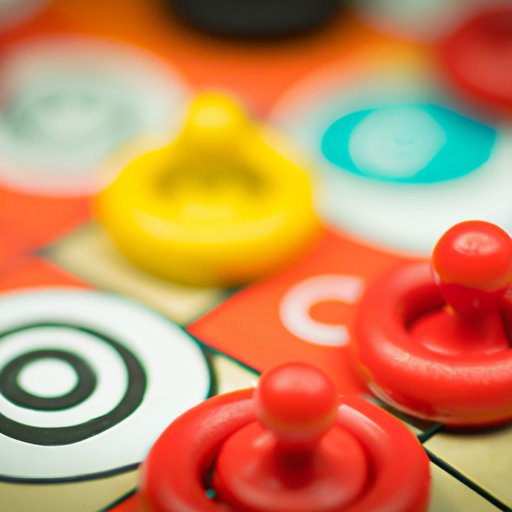
Introduction
Trouble is a classic board game that has been enjoyed by generations of families and friends. With its simple yet engaging gameplay, Trouble is a great way to spend an afternoon or evening with loved ones. Whether you’re a beginner or an experienced player, this comprehensive guide will help you learn how to play Trouble, improve your gameplay, and organize your own Trouble tournaments.

The Basic Rules of Trouble: A Perfect Guide for Beginners
The basic objective of Trouble is to be the first player to move all your colored pieces from your home area to the safety zone in the center of the board. Following are some of the basic rules of the game:
Equipment needed
Trouble requires a game board with a plastic dome in the center containing dice rollers, 16 colored pieces (four pieces of each color), and a set of instructions.
How to set up the game
Each player chooses a color and places their four pieces in their home area, marked with a color that matches their pieces. The players then takes turns rolling the dice to determine which player will go first. The highest number starts the game.
Game play instructions
The goal of the game is to move each of your colored pieces from your home area to the safety zone in the center of the board. To move your piece, you must roll a six. Once you roll a six, you get to move a piece out of your home area and onto the starting point on the board. From there, you can move your piece around the board based on the number you roll.
Common mistakes to avoid
One of the most common mistakes in Trouble is not taking advantage of opportunities to bump other players’ pieces back to their home area. Although it may be tempting to use all your rolls to move your pieces further along the board, taking the time to knock other players’ pieces back can give you a strategic advantage in the long run.
Strategies for Winning at Trouble: Tips to Lead You to Victory
While the gameplay of Trouble may seem straightforward, there are some strategies that can help you improve your chances of winning. Following are some useful tips to keep in mind:
Importance of a good opening move
The first move in Trouble is crucial to setting yourself up for success. Ideally, you want to move your piece as close as possible to the safety zone and avoid getting trapped behind other players’ pieces. However, be careful not to put your piece in a vulnerable position where your opponent can easily bump you back to your home area.
Importance of blocking opponents
Blocking your opponent’s pieces can be a great way to slow them down and give you time to get ahead. Be strategic about where you place your pieces, and don’t be afraid to sacrifice a move to block your opponent’s progress.
How to use the “pop-o-matic” dice roller to your advantage
The “pop-o-matic” dice roller in Trouble adds an element of chance to the game, making it more unpredictable. However, you can use it to your advantage by paying attention to the sounds it makes. By listening carefully, you may be able to guess what number will roll next and make strategic moves accordingly.
Tips for getting as many of your pieces “home” as quickly as possible
The key to winning Trouble is getting all your pieces safely to the center of the board. To do this quickly, focus on moving one piece at a time and making strategic moves that allow you to move your pieces towards the safety zone.
The Perfect Troublemaker: Exploiting Your Opponent’s Weaknesses
Winning at Trouble isn’t just about making strategic moves, it’s also about taking advantage of your opponents’ weaknesses. Here are some tips for being the perfect Troublemaker:
How to observe your opponent’s gameplay for weaknesses
Watching your opponent’s gameplay can help you identify their weaknesses and anticipate their moves. Pay close attention to how they move their pieces and what they seem to be focusing on.
Different strategies for taking advantage of your opponent’s weaknesses
One of the best ways to exploit your opponent’s weaknesses is to block their moves and force them to waste a turn. You can also take advantage of their mistakes by capitalizing on opportunities to bump their pieces back to their home area.
How to use bluffing tactics to your advantage
Bluffing can be a powerful tool in Trouble if used effectively. For example, if you have a piece near the safety zone, you can pretend to be more focused on moving another piece in order to trick your opponent into not blocking your progress.
The Benefits of Trouble: Why Playing This Classic Game is Good for You
Playing board games like Trouble comes with a number of benefits that can contribute to overall mental health and socialization. Following are some of the positive effects of playing board games:
The mental benefits of playing board games
Board games promote critical thinking, problem-solving, and decision-making skills. They help improve memory, concentration, and cognitive function, making them an ideal activity for people of all ages.
How Trouble contributes to brain development
Trouble requires a combination of strategic thinking and quick decision-making, which helps improve overall brain function and promotes the growth of neural connections. This is particularly important for children, whose brains are still developing.
How board games can improve mental health
Playing board games has been shown to reduce stress, anxiety, and depression levels. It promotes relaxation and has a soothing effect on the brain.
How playing Trouble can help people stay social
Board games like Trouble are a great way to connect with other people. They offer a fun and engaging way to spend time with friends and family members, and can help strengthen relationships.
Advanced Techniques for Trouble: A Comprehensive Guide to the Variations of the Game
Once you’ve mastered the basics of Trouble, there are a number of variations you can try to improve your gameplay. Following are some of the variations of Trouble:
Overview of different variations of Trouble
There are a number of variations of Trouble, including variations that involve more players, alternate rules, or different game boards.
Explanation of new rules and tweaks to the gameplay
New rules and tweaks to the gameplay can add an element of excitement and challenge to the game. For example, some variations allow players to move their pieces backwards, or they introduce new ways to get ahead that require more strategic thinking.
Strategies for winning at these different variations
The key to winning at any variation of Trouble is to stay focused and adapt to the new rules. Be open to trying new strategies and don’t be afraid to take risks.
Trouble as a Social Activity: How to Organize the Best Trouble Tournaments
Trouble tournaments can be a great way to gather friends and family members for a fun-filled day of friendly competition. Here are some tips for organizing a great Trouble tournament:
How to organize a Trouble tournament
Organizing a Trouble tournament starts with finding a group of players and setting a date and time for the event. You’ll need to make sure that you have all the necessary equipment for the tournament, and that the game board is big enough to accommodate all players.
Set up tips for large groups
If you’re organizing a tournament with a large group of people, you may want to consider breaking the group up into smaller teams. This can make the game more manageable and also add an element of teamwork to the event.
Tips for team play
In a team-based tournament, communication and collaboration are key. Be sure to set clear rules and expectations for each team, and encourage players to work together to come up with winning strategies.
Prizes and incentives for winners
To make the tournament more exciting, you may want to offer prizes or incentives for the winning team or player. This can be as simple as a small trophy or prize, or as elaborate as a prize package that includes gift cards, board games, and other goodies.
Trouble and Beyond: What Playing Trouble Can Teach You About Life
Playing Trouble can teach us a lot about life and how to approach challenges. Here are some life lessons we can learn from playing Trouble:
Linking life lessons to the basics of Trouble
By drawing parallels between the gameplay of Trouble and real-life situations, we can learn how to navigate difficult situations and come out on top.
Lessons learned from success and failure in gameplay
Playing Trouble teaches us that success and failure are both part of the game. By learning from our mistakes and celebrating our successes, we can build resilience and improve our overall gameplay.
Critical thinking skills and how they apply to gameplay and life
Playing Trouble requires critical thinking skills and strategic planning. These skills can be applied to everyday life, helping us make better decisions and solve problems more effectively.
Conclusion
Trouble is more than just a game – it’s a way to spend quality time with loved ones, improve cognitive function and mental health, and even learn valuable life lessons. Whether you’re a seasoned player or a first-time beginner, the tips and strategies in this comprehensive guide can help you improve your gameplay and enjoy all that the game of Trouble has to offer.





